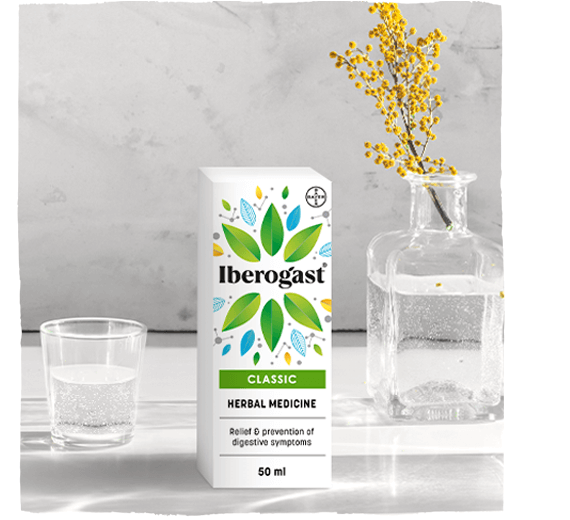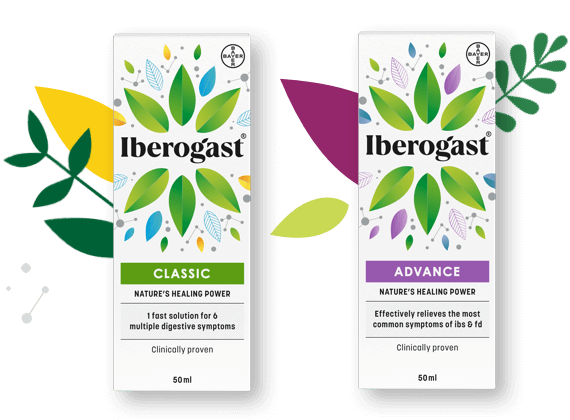Caraway fruit (Carvi fructis) – much more than a culinary herb
One of the main natural remedies against heavy digestion is caraway, a medicinal plant of the same family as fennel. Caraway is often the spice of choice in the preparation of many dishes such as fried potatoes, sauerkraut or even bread. But it is not only the taste that makes caraway so special - its slightly relaxing effect transforms difficult-to-digest, flatulent or high-fat meals into well digestible ones.
As an ingredient of Iberogast®, caraway fruits contribute to its tonicizing effects on the gastrointestinal tract.
Also known as Persian cumin, caraway is native to the Middle East, Europe and North Africa. The origins of the name are highly disputed, as both the Greek (karon) and the Sanskrit (karavi) descriptors have also been used as names for other plants (cumin and fennel).
The first know use of caraway dates back to 3000 before christ, as dried fruits were found in the foundations of houses dated to that period.
The first written testimony of usage dates to around 200 after Christ in an old Roman recipe collection.
Also known as Persian cumin, caraway is native to the Middle East, Europe and North Africa. The origins of the name are highly disputed, as both the Greek (karon) and the Sanskrit (karavi) descriptors have also been used as names for other plants (cumin and fennel).
Extracts of caraway fruits have several benefits: They not only have an antispasmodic effect, but also help with flatulence and fullness. Due to its germicidal effect, caraway can also counteract inflammation in the gastrointestinal tract.
In Iberogast® the extracts of caraway fruits contribute to its anti-inflammatory and mucosa protective effect.
In general, the valuable ingredients of the caraway are used for the symptomatic relief of digestive disorders such as bloating and flatulence. Additionally, caraway has been officially recognized by the European Scientific Cooperative on Phytotherapy (“ESCOP”) as an agent for resolving stomach complaints and flatulence in children often suffering from colics.
Caraway is derived from controlled sources of cultivation for pharmaceutical processing. It is primarily grown in Germany, but also in Eastern Europe. Pure caraway grows in loamy soil. Pure caraway can be cultivated in one or two-year cycles. Seeds are sown in the spring.
Weed control usually takes place either mechanically or using approved pesticides, particularly in the two-year cycle as the plants need to establish themselves as powerful, healthy plants during the first year. A good supply of water is also required for a two-year cycle so that healthy plants can establish themselves and survive the winter.
Harvesting takes place using a combine harvester from June (two-year cycle) and from August in a one-year cycle. It is important that the fruits are harvested without their stems. Caraway is dried, cleaned and stored using different drying processes depending on the grower. Drying temperatures that are too high reduce the nutrient content, particularly of essential oils.
First know uses of caraway seeds
It is important to know that the caraway seeds are not seeds at all. The fruits of the caraway plant grow as achenes – dried, simple fruits, containing only one seed each. The first know use of caraway dates back to 3000 B.C., as there have been dried fruits found in the foundations of houses dated to that period. The first written testimony dates to around 200 A.D. in the old Roman recipe collection De re coquinaria (On the subject of cooking), also known as the Apicus.

The effect of caraway fruits on the gastrointestinal tract
Caraway fruits have several benefits: They not only have an antispasmodic effect, but also help with flatulence and fullness.
Caraway has been officially recognized by the European Scientific Cooperative on Phytotherapy (“ESCOP”) as an agent for resolving stomach complaints and flatulence in children often suffering from.
The valuable ingredients of the caraway stimulate digestion. Due to its germicidal effect, caraway can also counteract inflammation in the gastrointestinal tract. in Iberogast® the extracts of caraway fruits contribute to its anti-inflammatory and mucosa protective effect.
At a glance: this is how caraway fruits in Iberogast® affect digestion
The following table shows the different active contributions of caraway fruits in Iberogast®:
| Active benefits of caraway fruits in the frame of irritable stomach | |
| Activation of the musculature in the lower stomach | |
| Relaxation of the musculature in the upper stomach | |
| Anti-inflammatory | |
| Regulation of acid production | |
| Protection of the mucosa |
Legend:
| High impact | |
| Medium impact | |
| Light impact |
The below video is an example only. Please localize the videos in the content packages (can be found on eDAM) and here with your local market Vimeo/YouTube links
This is a sample video only. Please replace with your own local country Vimeo/YouTube videos.
Interesting facts about caraway fruits
Did you know, that:
-Caraway was said to have mystical abilities in the Middle Ages? For example, a bag of caraway fruits worn around the neck was considered a defence against evil spirits.
-Caraway is one of the most common wild growing medicinal plants in Germany?
-Only the crescent-shaped, brown and strongly aromatic caraway fruits can be used as a spice?
-The plant thrives on all slightly calcareous, nutrient-rich soils? In addition, she prefers to grow on meagre grasslands, along the way and on sunny, sheltered spots.
Get an overview of the medicinal plants contained in Iberogast® here.
Buy Iberogast® prescription-free from your pharmacy.
Get the power of nature into your home!

Abdel-Aziz, H., O. Kelber, G. Lorkowski and M. Storr “Evaluating the Multitarget Effects of Combinations through Multistep Clustering of Pharmacological Data: the Example of the Commercial Preparation Iberogast.” Planta Med, 2017. 83(14/15): 1130–1140.
Schemann, M., K. Michel, F. Zeller, B. Hohenester and A. Ruhl “Region-specific effects of STW 5 (Iberogast) and its components in gastric fundus, corpus and antrum.” Phytomedicine, 2006. 13 (Suppl 5): 90–99.
Ammon, H. P., O. Kelber and S. N. Okpanyi “Spasmolytic and tonic effect of Iberogast (STW 5) in intestinal smooth muscle.” Phytomedicine, 2006. 13 (Suppl 5): 67–74.
European Medicines Agency: EMA/HMPC/715092/2013 – “European Union herbal monograph on Carum carvi L., fructus.” Published 14 November 2014. Available from: https://www.ema.europa.eu/documents/herbal-monograph/draft-european-union-herbal-monograph-carum-carvi-lfructus_en.pdf.
Carvi fructus, ESCOP monographs 2003.








